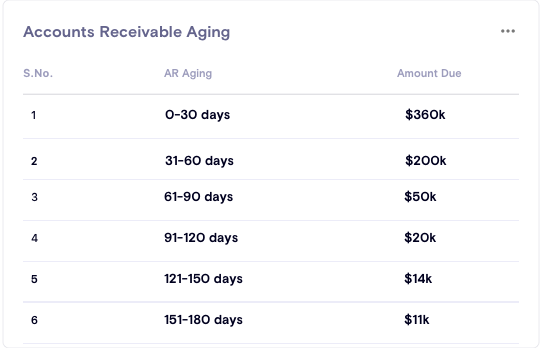PRODUCT
SOLUTIONS
- BY INDUSTRY
- B2B SaaS
- eCommerce
- E-learning
- Publishing
- BY BUSINESS SIZE
- Startup
- ScaleUp
- Enterprise
- BY BUSINESS MODEL
- Self-serve
- Sales-driven
CHARGEBEE RETENTION
Accounting and Taxes
What is an Accounts Receivable aging report?
AR report helps determine the effectiveness of credit & collection functions and identifies existing irregularities in the collection process.
Example of AR Aging Report
An AR aging report segregates the past due date invoices in date ranges (like 30 days) from the day the invoice was issued to the customer. For example, John Doe of XYZ company’s AR aging in his balance sheet will look like:
30 days overdue: $100
60 days overdue: $200
60+ days overdue: $700
Here’s what an accounts receivable aging schedule looks like:

The AR aging report helps you understand the average age of your outstanding invoices. It will help you collect bills within a stipulated period, improve efficiency, and move the money to your bank account.
Importance of AR aging report
Tracking your AR aging report regularly (weekly or monthly) will help you identify concerns before the situation escalates to cash-flow problems.
By analyzing customers’ late payment history, you can tweak your AR processes accordingly to maximize the collection efforts.
It will also help you withhold product/service offerings until the customer pays the amount on the specific due date. It will ensure you don't lose money by providing your service/product without payment.
It gives a deeper insight into your customers’ business, and aligning your invoice timeline with theirs will increase the chances of getting paid on time.
How to Create AR Aging Report
Here’s how you can create accounts receivable aging report:
Start with reviewing all outstanding invoices.
Segregate the invoices using the aging schedule and the amount due.
Now you should have a list of customers with overdue accounts.
Categorize these customers based on the total amount due and the number of days outstanding.
If you have revenue analytics integrated with your accounting software, this process becomes a whole lot easier. This is how an accounts receivables aging report in Chargebee Analytics looks like:

How to Use an AR Aging Report
The accounts receivable aging report gives a snapshot of the status quo of your pending invoices and presents some actionable insights to improve your AR workflows. You can use the AR aging report for:
Determining the average collection period
Based on your customer payment trends, you can calculate the average collection period, which is the average number of days it takes to collect your receivables. If the ratio goes up over time, then it is time to evaluate your payment terms. The average collection period can be calculated using the formula:
Avg. Collection period = [(Days in period x Avg accounts receivable) / Net credit sales]
Revisiting credit policies
If you notice the number of doubtful accounts creep up, it is time to revisit the credit terms and policies. You also need to review your dunning workflows and experiment with dunning emails to see what works best. You can introduce payment terms to extend the payment periods by 10, 15, 30, 45, or 60 days. It gives customers the time to review invoices and plan for their accounts payable and can be particularly valuable for small business owners.
Proactively tracking potential cash flow problems
A company’s accounts receivables are vital to maintaining a healthy cash flow. AR aging report can help surface potential credit risks and lets you take preemptive measures to keep your cash flow healthy.
Here’s more on managing your AR during a crisis.
Strategize collection efforts
AR aging report helps you plan your collection efforts better. For example, if you have outstanding invoices for more than 60-90 days, you may need more rigor in your collection efforts. You can even work with collection agencies for these accounts. For invoices that are pending for less than 30 days, smart dunning mechanisms should suffice.
Estimating bad debts and allowances
The accounts receivable aging report helps estimate the amount of bad debt and doubtful accounts. When a receivable is deemed uncollectible from an account, it’s called a doubtful account and the amount becomes a bad debt. Bad debts need to be written off in financial statements, and allowances must be made for doubtful accounts to ensure accurate and compliant bookkeeping.
Head here for some best practices on AR automation.
Conclusion
An accounts aging report helps you maintain a healthy and continuous cash flow. It helps in eliminating receivables problems early on and reduces the risks of bad debts. Having a clear understanding of the customer’s invoices (invoice dates, amount outstanding, and the payment history) will help you estimate how the money will flow into your business. It is important to get real-time reports on your receivables and automate your payment reminders in sync with your pending invoices.
Chargebee is a subscription billing management platform that automates your recurring billing. Here’s how Chargebee can help you automate AR aging reports and set up follow-up mechanisms to send timely reminders.